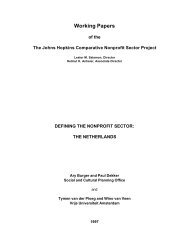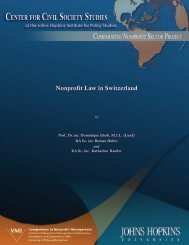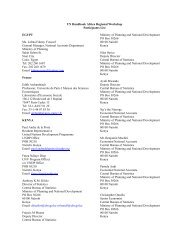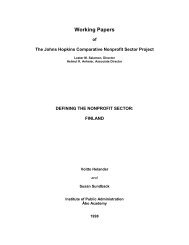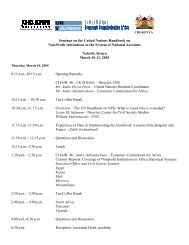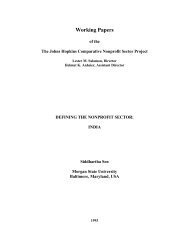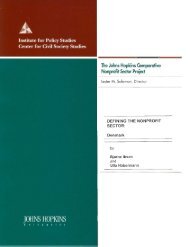Campetella, González Bombal, and Roitter<strong>Defining</strong> <strong>the</strong> <strong>Nonprofit</strong> <strong>Sector</strong>: <strong>Argentina</strong>organizations. There are currently almost 12,400 cooperatives distributed as follows: 34 percentworkers’ cooperatives, 20 percent housing cooperatives, 15 percent in <strong>the</strong> agricultural and livestockfield, 14 percent in <strong>the</strong> provision of utilities, and <strong>the</strong> rest in <strong>the</strong> credit, consumption and insurancefields.According to <strong>the</strong> criteria set by <strong>the</strong> Johns Hopkins Comparative <strong>Nonprofit</strong> <strong>Sector</strong> Project, wewill consider only three types of cooperatives within <strong>the</strong> core coverage: workers’, agricultural andlivestock, 18 and utilities. The rest –i.e. commercial, industrial, banks and insurance– will be countedand reported on separately, since, although <strong>the</strong>y are important in <strong>the</strong> Argentine context, <strong>the</strong>y operatesimilarly to for-profit organizations.Obras Sociales (Workers’ Medical Care Organizations)The obras sociales emerged from <strong>the</strong> mutual benefit associations created at <strong>the</strong> end of <strong>the</strong>19 th century. Since <strong>the</strong> development of <strong>the</strong> welfare state in <strong>the</strong> mid-1940s, several mutualassociations related to trade unions were integrated within a national health care system, and startedto operate closely related to <strong>the</strong> trade union legally recognized by <strong>the</strong> state in each activity branch.In 1970 a first Law on Obras Sociales was enacted, requiring workers’ compulsoryaffiliation, and <strong>the</strong>refore, workers’ compulsory contribution. This contribution, toge<strong>the</strong>r wi<strong>the</strong>mployers’ compulsory contribution stipulated during Perón’s government, constituted <strong>the</strong>organizations’ income. The law also created <strong>the</strong> National Institute of Obras Sociales (INOS) as <strong>the</strong>public agency in charge of coordinating <strong>the</strong> services provided by <strong>the</strong>se organizations within <strong>the</strong>national health care system.The integral coverage provided by <strong>the</strong> obras sociales makes <strong>the</strong>m a peculiar system thatfulfills <strong>the</strong> principles of national health care systems –i.e., universal coverage and services– even to agreater extent than o<strong>the</strong>r Latin American systems especially created to this end. This has led expertsto compare <strong>the</strong> obras sociales with a real national health care insurance (Hengstenberg andCracogna, 1988).This system is currently being modified, but this modification is gradual because of <strong>the</strong>diversity of interests involved in it. A large number of difficulties laying ahead for <strong>the</strong> final sanctionof <strong>the</strong> labor reform that is currently discussed in <strong>Argentina</strong> are related to <strong>the</strong> system of obrassociales. They are a central piece of <strong>the</strong> bargaining power held by trade unions in <strong>the</strong>ir negotiationswith <strong>the</strong> state and <strong>the</strong> business sector, and <strong>the</strong>y hold a captured market to which private for-profi<strong>the</strong>alth corporations want to have access. A recent modification introduced in 1996 was <strong>the</strong>elimination of compulsory affiliation to <strong>the</strong> obra social of <strong>the</strong> corresponding trade union, thusallowing workers to choose freely among <strong>the</strong> spectrum of <strong>the</strong> existing obras sociales -that is, notincluding private for-profit corporations.18Most of <strong>the</strong> cooperatives defined as agricultural and livestock cooperatives are small organizations set up in <strong>the</strong>provinces that meet <strong>the</strong> definition of nonprofit organizations. There are a few cases of large cooperatives in <strong>the</strong>agricultural field, but <strong>the</strong>y fall into <strong>the</strong> category of industrial cooperatives and <strong>the</strong>y are consequently excluded from<strong>the</strong> core coverage.17
Campetella, González Bombal, and Roitter<strong>Defining</strong> <strong>the</strong> <strong>Nonprofit</strong> <strong>Sector</strong>: <strong>Argentina</strong>The legal status of obras sociales is a controversial topic, owing to <strong>the</strong> current reforms aswell as to <strong>the</strong> great heterogeneity of institutions it encompasses. Generally speaking, obras socialesare considered associations in <strong>the</strong> broad sense, that is, <strong>the</strong>y enjoy <strong>the</strong> legal status of private nonprofitpersons, and thus, <strong>the</strong>y are under <strong>the</strong> control of <strong>the</strong> General Justice Inspection. However, <strong>the</strong>y arealso regulated by a specific law, <strong>the</strong> revised Law on Obras Sociales, passed in 1988 and enacted in1989, which defines <strong>the</strong>m as agents of <strong>the</strong> National System of Health Insurance and establishes that<strong>the</strong>y are under <strong>the</strong> control of <strong>the</strong> Health and Social Assistance Ministry. The Law clearly expresses<strong>the</strong> heterogeneity of <strong>the</strong> universe of obras sociales, distinguishing eight types: those related to tradeunions; those of professional business and corporate managers’ associations; those created byagreement with <strong>the</strong> business sector; those created by national laws; <strong>the</strong> ones related to <strong>the</strong> statebureaucracy; those of state-owned enterprises; those related to <strong>the</strong> security forces; and any o<strong>the</strong>rs notincluded in <strong>the</strong> previous categories. Hereinafter we will refer only to <strong>the</strong> first three types, which areprivate entities, unlike <strong>the</strong> rest which are public, non-state entities.The inclusion of <strong>the</strong>se three types of obras sociales within <strong>the</strong> nonprofit sector is a debatableissue 19 due to <strong>the</strong> particular development of <strong>the</strong>se organizations, specifically <strong>the</strong>ir close relation totrade unions and <strong>the</strong> compulsory nature of <strong>the</strong>ir affiliation. We will consider <strong>the</strong>m as hybrid cases,bearing in mind <strong>the</strong>ir essential role in <strong>the</strong> provision of health services for wide sectors of <strong>the</strong>population, <strong>the</strong> absence of profit objectives, and <strong>the</strong> current processes of deregulation that will define<strong>the</strong>ir future and definite status.Trade UnionsThe origin of trade unions can be also traced back to <strong>the</strong> mutual benefit associations createdin <strong>the</strong> 19 th century, particularly those created on <strong>the</strong> basis of <strong>the</strong> trade of <strong>the</strong>ir members. UnderPeronism important transformations took place, which included <strong>the</strong> expansion of state interventionand <strong>the</strong> central role of trade unions.Trade unions are currently considered as associations in <strong>the</strong> broad sense, i.e., <strong>the</strong>y enjoy <strong>the</strong>legal status of private nonprofit persons and thus <strong>the</strong>y are under <strong>the</strong> control of <strong>the</strong> General JusticeInspection. At <strong>the</strong>ir specific level <strong>the</strong>y are regulated by <strong>the</strong> Law of Workers Trade Unions No. 23551–enacted in 1988– and <strong>the</strong>y are under <strong>the</strong> control of <strong>the</strong> National Ministry of Labor and SocialSecurity. This Law guarantees trade union freedom –to both create and join <strong>the</strong>m– and <strong>the</strong>constitution of trade unions for activity branches, trade or corporations. However, it also establishes<strong>the</strong> status of personería gremial (trade union legally recognized by <strong>the</strong> state), which is acquired onlyby <strong>the</strong> trade union that is <strong>the</strong> most representative in its activity branch.According to Article 25, <strong>the</strong> most representative association in its territorial and personalcoverage will obtain <strong>the</strong> status of personería gremial, as long as it fulfills <strong>the</strong> followingrequirements: (a) to be registered according to <strong>the</strong> law and in operation for not less than six months;19In this regard, it is worth mentioning that obras sociales are excluded from <strong>the</strong> economie sociale, due to <strong>the</strong> fact that<strong>the</strong>y are not self-administered organizations. The main arguments are that <strong>the</strong> capital is constituted by fundsprovided by <strong>the</strong> beneficiaries –<strong>the</strong> workers– but also by non-beneficiaries –<strong>the</strong> employers–; that <strong>the</strong> state stronglyregulates and intervenes in <strong>the</strong> national health care system in which <strong>the</strong>se entities are included; and that <strong>the</strong>y areadministered by <strong>the</strong> related labor union (Hengstenberg and Cracogna, 1988).18
- Page 1 and 2: Working PapersofThe Johns Hopkins C
- Page 3 and 4: PREFACEThis is one in a series of W
- Page 5 and 6: Campetella, González Bombal, and R
- Page 7 and 8: Campetella, González Bombal, and R
- Page 9 and 10: Campetella, González Bombal, and R
- Page 11 and 12: Campetella, González Bombal, and R
- Page 13 and 14: Campetella, González Bombal, and R
- Page 15 and 16: Campetella, González Bombal, and R
- Page 17 and 18: Campetella, González Bombal, and R
- Page 19: Campetella, González Bombal, and R
- Page 23 and 24: Campetella, González Bombal, and R
- Page 25 and 26: Campetella, González Bombal, and R
- Page 27 and 28: Campetella, González Bombal, and R
- Page 29 and 30: Campetella, González Bombal, and R
- Page 31 and 32: Campetella, González Bombal, and R
- Page 33: Campetella, González Bombal, and R



